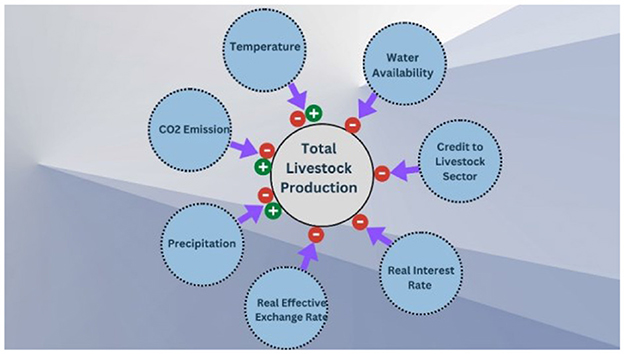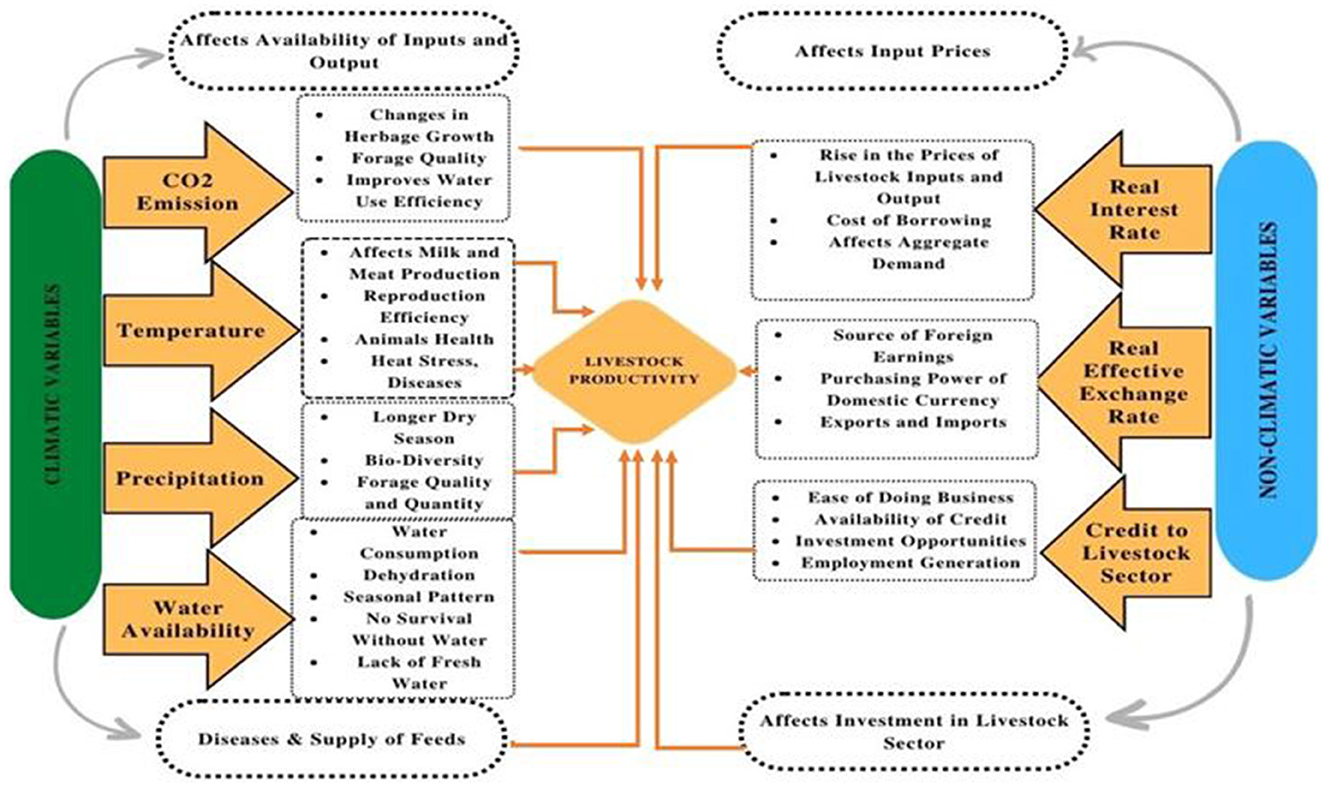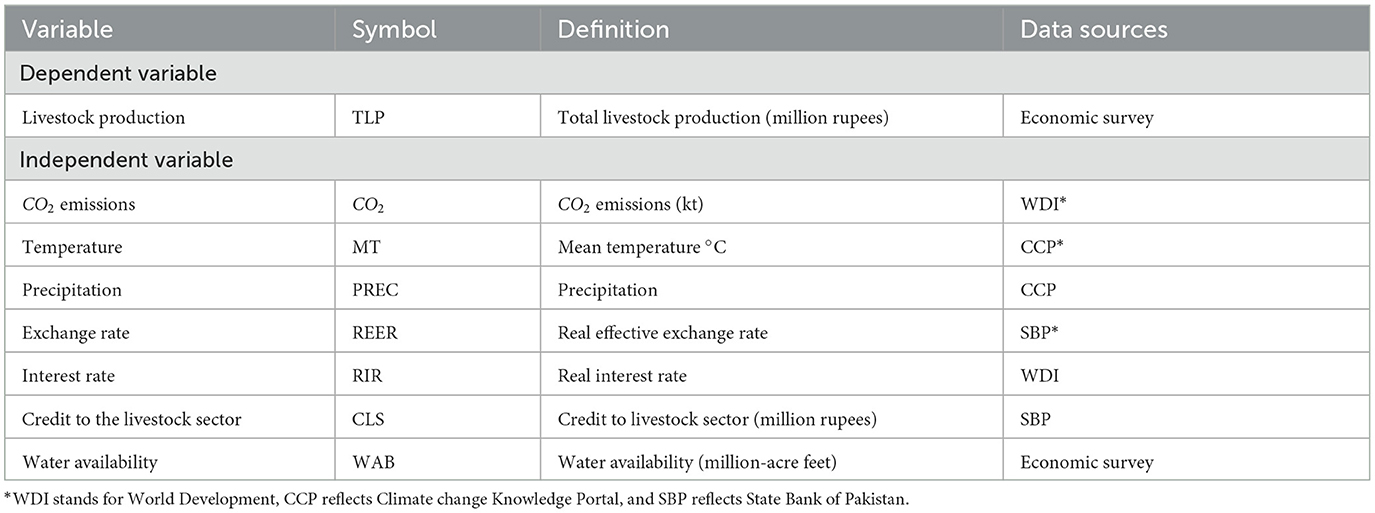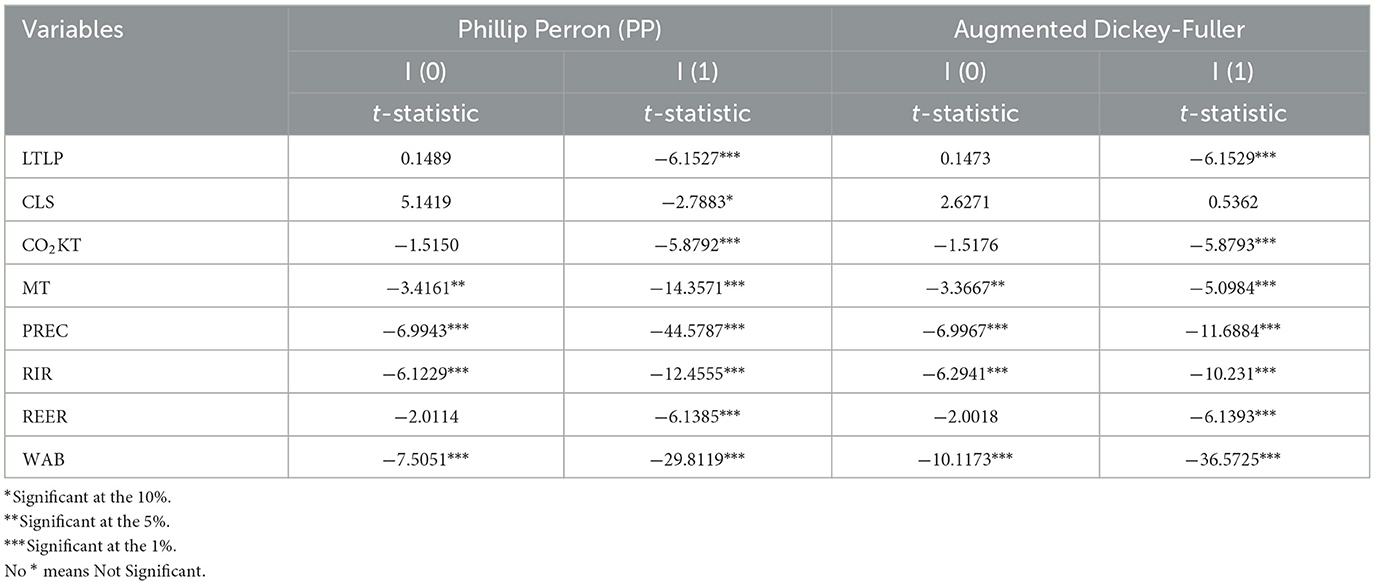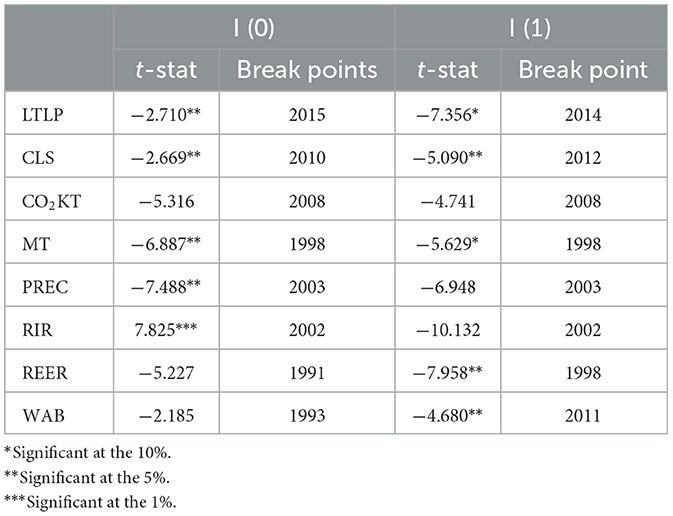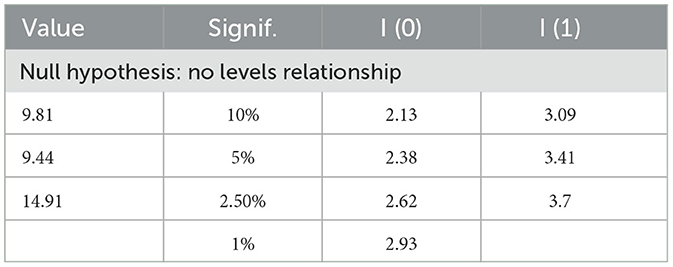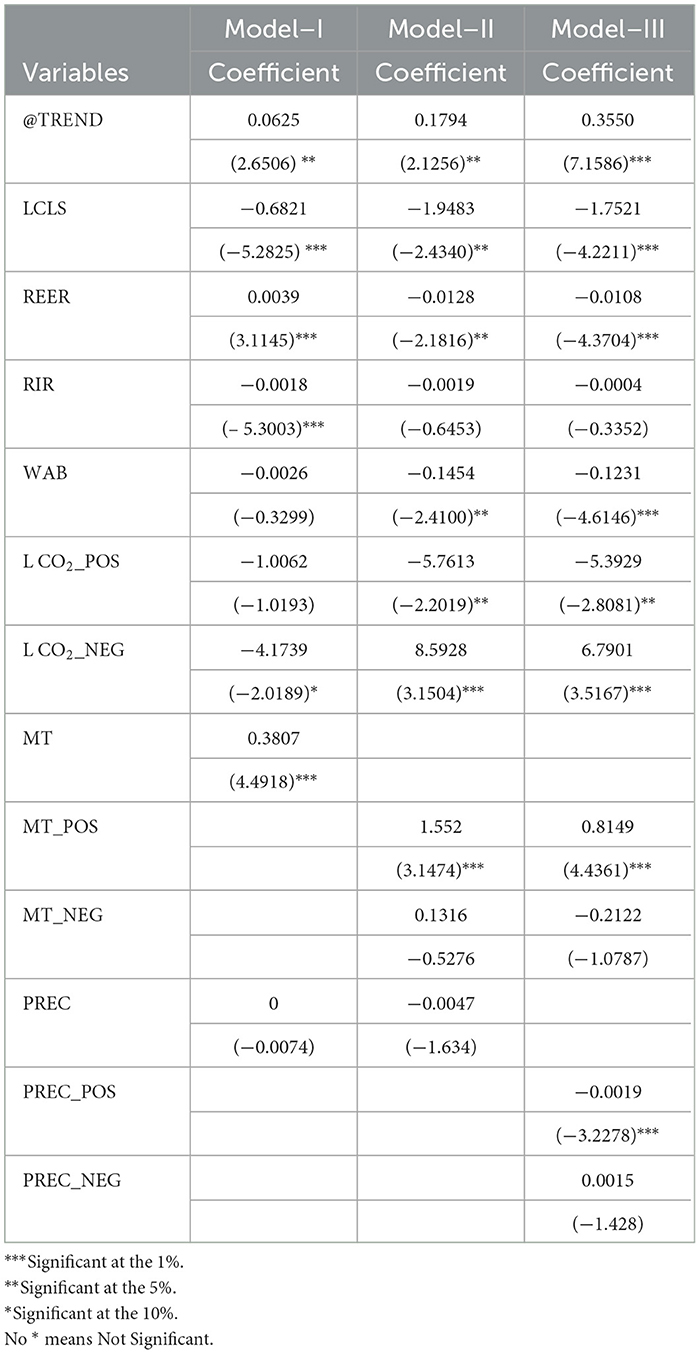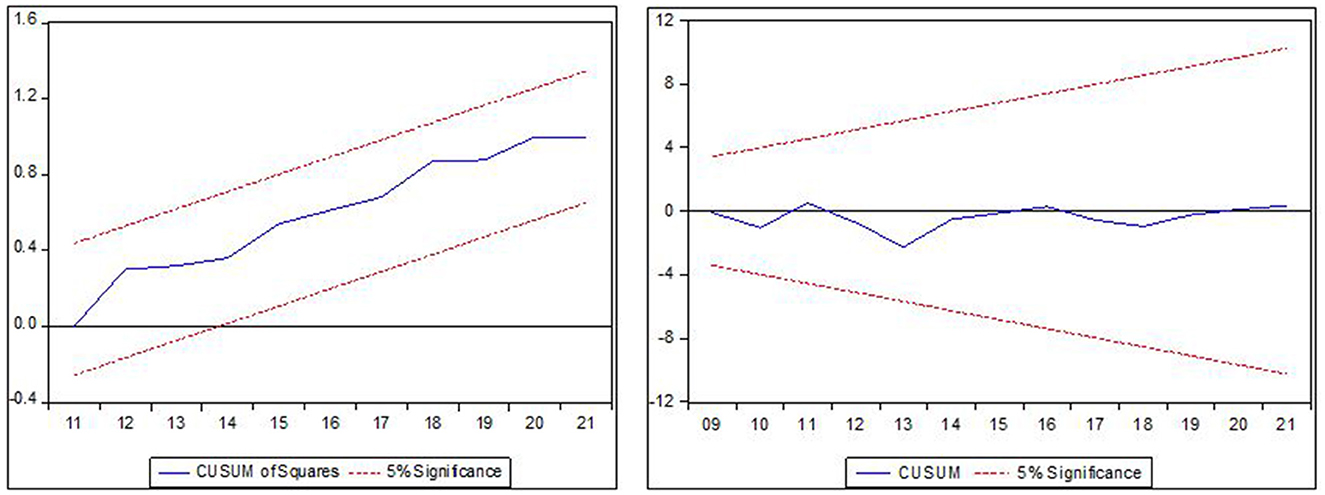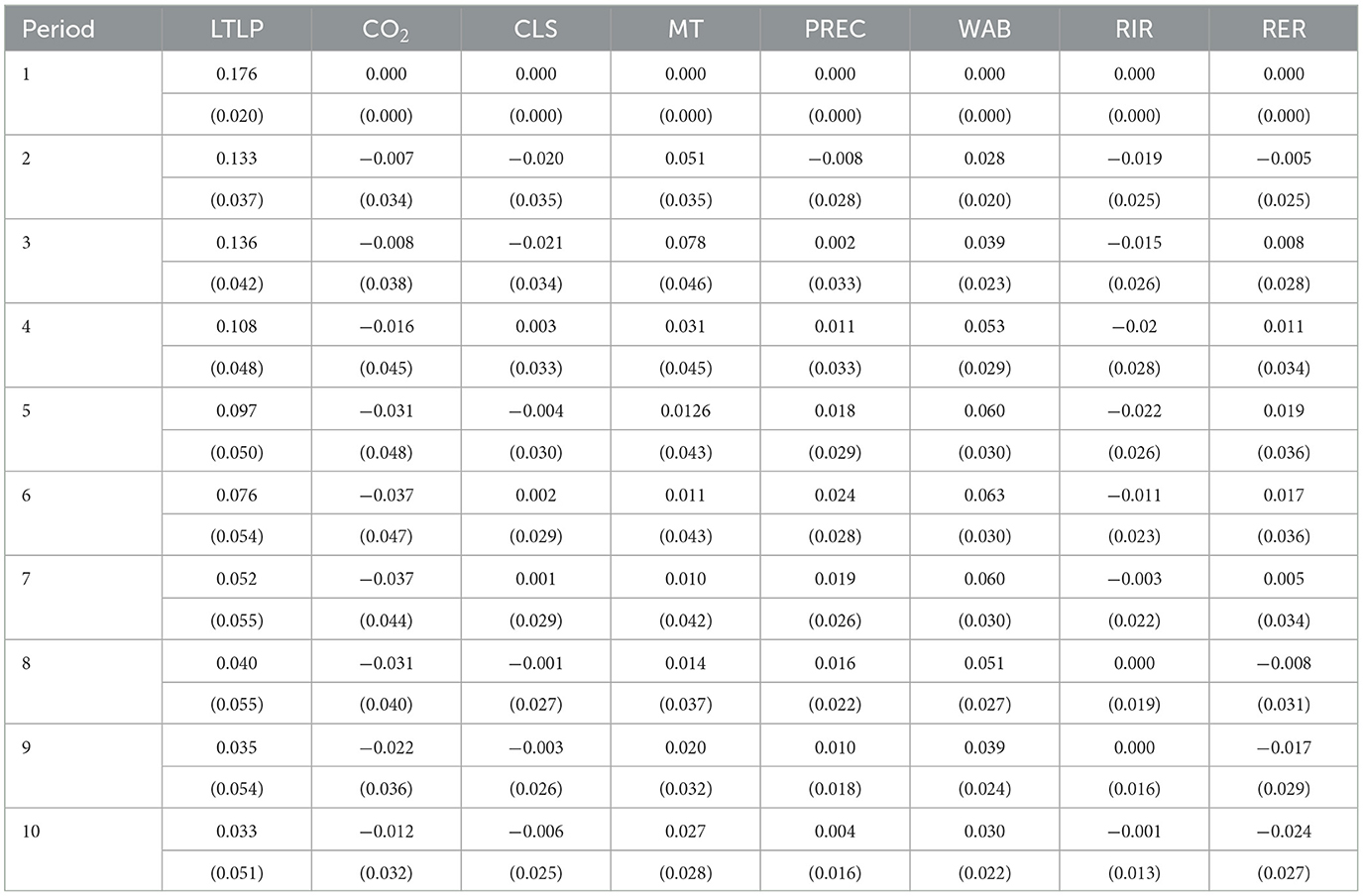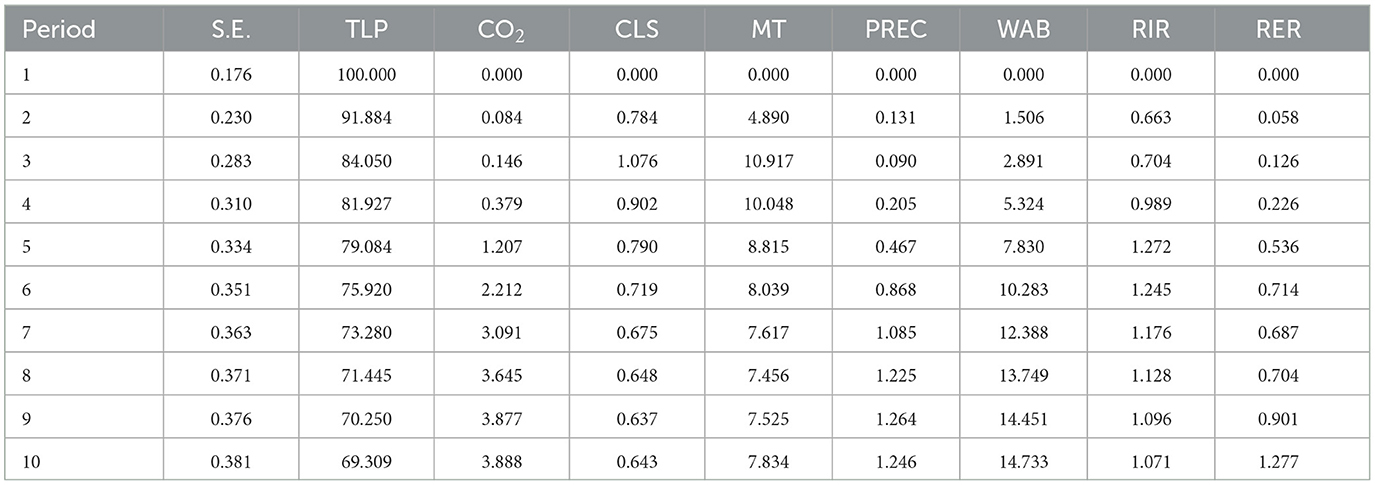Asymmetries in climate change and livestock productivity: non-linear evidence from autoregressive distribution lag mode
- 1Department of Economics, COMSATS University, Islamabad, Pakistan
- 2College of Business, Al Ain University, Al Ain, United Arab Emirates
- 3Department of Finance, Accounting and Finance, University of Pitesti, Piteşti, Romania
Introduction: The livestock sector is extremely important to Socioeconomic growth in Pakistan, yet it is also quite vulnerable to weather changes. Climate change reduces livestock production by changing ecosystem services such as water availability, feed quality and quantity, disease outbreaks, animal heat stress, and a decline in livestock variety and breeds. Climate change has a direct impact on ecological and animal health. As a consequence of climate change, animal diseases, and infections are becoming more widespread. With the non-linearities of climate change in the livestock industry in mind, the present study investigated the asymmetric influence of climatic and non-climatic variables on livestock productivity across Pakistan. The empirical analysis was conducted utilizing secondary time series data from 1980 to 2021.
Method: The non-linear autoregressive distributive lag (NARDL) model is used to examine the asymmetric behavior of climatic variability in the livestock sector. We included CO2 emissions, mean temperature (MT), and precipitation (PERC) as climatic variables in the current study, along with additional control factors.
Results and discussion: Our research discovered that CO2, MT, and PREC had asymmetries in their impacts on livestock. Variations in CO2, MT, and PREC have contradictory effects on livestock productivity in the long and short term. A percent increase in LCO2 leads to a fall in livestock production insignificantly by 1.0062% for Model I and significantly by 5.7613% and 5.3929% for Models II and III, respectively. A percent decrease in LCO2 significantly lowers livestock production by 4.1739% for Model I and improves livestock production by 8.5928% and 6.7901%, respectively, for Model II and Model III. A unit increase in MT significantly improves livestock productivity by 1.5520% and 0.8149% for Models II and III, respectively, while a unit decrease in MT insignificantly improves livestock production by 0.1316% and 0.2122% for Models II and III, respectively. A unit increase and decrease in PREC significantly lowers and insignificantly improve livestock productivity respectively by 0.002% in both cases for Model III. To protect the livestock industry from the negative effects of climate change, this study suggests that livestock producers use new environmentally friendly technologies and ecological agricultural systems.
1. Introduction
The global consumption of meat and related products is predicted to surge in the next few years due to a variety of factors, including greater urbanization, rising incomes, dietary changes, and population growth (Thornton et al., 2009; Nardone et al., 2010; Ayanlade and Ojebisi, 2019; Mihiretu et al., 2019). Nonetheless, owing to the changing climate and extreme weather occurrences, global worry is growing regarding the livestock industry's potential to cope with the increased demand for its products (Escarcha et al., 2018). Climate change has far-reaching implications for the cattle business. It reduces the quantity of readily available water for livestock to consume (Mihiretu et al., 2019), resulting in decreased animal productivity (Rojas-Downing et al., 2017). Rising temperatures are also anticipated to double or triple animal water usage (Nardone et al., 2010).
A changing climate, namely, a temperature rise resulting in very little rain, impedes the growth of fodder essential for cattle grazing and the proliferation of cattle themselves (Rojas-Downing et al., 2017). As a result, any reduction in food and fodder crop supply affects livestock productivity, as measured by meat and dairy product output and the reproductive system. Furthermore, rising temperatures and erratic rainfall, whether in the form of food or droughts, jeopardize animal health and wellbeing by directly or indirectly exposing them to a variety of illnesses. It is critical to highlight that the impacts are not consistent; they differ depending on the kind of animals, region, sickness etiology, and animal susceptibility (Thornton et al., 2009). Animal dying (Nardone et al., 2010) and mortality (Rojas-Downing et al., 2017) are the primary direct effects of these two factors on the livestock sector, while indirect impacts include increased pathogens or parasites, accelerated outbreaks of existing or new diseases, and transmission of food-borne diseases (Thornton et al., 2009; Nardone et al., 2010).
Climate change increases the likelihood of severe drought in nations that rely on rainfall for natural pasture development, such as Asian countries (Khurshid et al., 2022). This is due to changes in the rain pattern, which increases the risk of death and poverty. Other effects include rural-urban migration from contaminated grazing regions, increased poverty, and a loss in export income and economic growth.
Pakistan is susceptible to climate change due to its geographical location and dependency on water resources, especially agriculture, which is the backbone of the Pakistani economy (Abbas, 2022). Pakistan is among the top 12 countries vulnerable to climate variations and trends. Climate change is decelerating Pakistan's economy since it immediately impacts the agriculture industry, the country's backbone, and all other sectors. The livestock sector accounts for ~61.89% of agricultural production and is one of the most active and vital industries (GOP, 2022). The livestock sector in Pakistan is crucial since it is a major component of the country's agriculture sector. Temperature and precipitation changes affect Pakistan's livestock sector. Demand for cattle products is also rising due to population growth and urbanization, with Pakistan's urban population expected to rise to 54% from 36% by 2050 (UN, 2018). The cattle business in Pakistan is particularly vulnerable to climate change, which has a long-term detrimental impact on the economy. Pakistan's cattle business is vital to economic growth, poverty alleviation, and increased foreign exchange revenues. Livestock is a source of investment revenue for many rural and marginalized people, and for many, it is their entire source of income. Since livestock is more equally distributed than land, growth in livestock production may have a higher impact on decreasing poverty than an increase in crop yields (Shukla, 1999; Birthal et al., 2019).
In Pakistan, as the human population and urbanization increase, so does the demand for cattle products. Concurrently, changing climatic circumstances have a significant and long-term negative impact on people, agriculture, and animal systems. Climatic factors, such as precipitation and temperature, have a considerable impact on animal productivity (Ali and Erenstein, 2017). Temperature rise causes thermal stress in aquatic and terrestrial animals, decreases cattle development, shortens immunological competence, and reduces production. The temperature rises also raise livestock industry spending since more investment is required to safeguard cattle from rising temperatures (Rojas-Downing et al., 2017). Other climate factors, such as precipitation behavior, unpredictable rainfall patterns, and irregular monsoons, resulted in the extinction of livestock species, significantly impacting food security and the income of marginalized people. The impact of climate change will be increasingly severe and important to the availability of feed, forage, and other livestock goods and byproducts (Baumgard et al., 2012). According to the literature, these climate changes have an unequal impact on the agricultural sector and cattle productivity. Numerous studies have been undertaken globally to examine how climate change may affect the livestock industry. The literature shows that these climatic changes affect the agricultural sector and livestock production asymmetrically (Ahmad et al., 2019). The behavior and pattern of climatic variables are non-linear, and in the case of Pakistan, no study has been found assessing the non-linear impact of climatic variables. The purpose of this study is to fill a gap in the literature by investing in the non-linear or asymmetric impact of climate change on the livestock sector. This study investigates the sensitivity of Pakistan's livestock production to climate change.
Pakistan is a developing nation striving to achieve suitable and long-term growth, but it cannot overcome its economic crisis. Lack of innovation, non- or late adaptation of advanced technology, efficient strategies, structural transformation, political and social instability, environmental degradation, and climate change are the reasons for the slow growth of the economy. The agriculture sector is dominant, and the economy of Pakistan strongly relies on this sector, especially the crops and the livestock sector. The livestock sector is growing but at a decreasing or diminishing rate. Livestock is a significant source of food items, clothing, and other byproducts, and exports of livestock products are also a major source of foreign reserves for the economy of Pakistan. The livestock sector of Pakistan experiences various challenges, like issues of animal health and welfare, environmental degradation, and the impact of climate change.
This study aims to investigate the asymmetric behavior of climatic changes in the livestock sector in Pakistan in light of the rising demand for livestock products and the negative impact of climate change on livestock products. Much research has been conducted in Pakistan so far, but few studies have estimated the effect of climate change on livestock. Livestock is a significant sector with a potential impact on Pakistan's economy. As a volatile sector, it is highly affected by climatic variation, both directly and indirectly, through the agricultural sector. People's involvement in livestock is greater than in any other subsector of the agriculture sector in Pakistan, and this factor increases its importance as it is one of the major and main sources of livelihood for livestock farmers. Much research in Pakistan has been done to date, but few have estimated the effect of climate change on livestock. It is not only a detailed study of livestock productivity concerning climatic variables but also fills the literature gap on economic variables such as the impact of credit on livestock-on-livestock productivity.
The current study fills a knowledge gap by investigating the uneven impact on Pakistan's cattle industry. The impact of climate change on livestock production is significant, but the economic value of this impact is largely unknown due to a lack of sufficient research. Each year, various factors related to climate change, such as damaged fodder, the spread of diseases, excessive or untimely rainfall, floods, and droughts, lead to a reduction in livestock production. Since Pakistan's economy relies heavily on agriculture, particularly the livestock sector, it is imperative to focus on this sector. Pakistan is facing environmental degradation and climate change, which pose a significant threat to the country's sustainable development. Therefore, it is essential to conduct further research to address the adverse effects of climate change on the livestock sector and implement timely interventions and measures to mitigate its impact on the sector and the overall economy of Pakistan. Furthermore, the livestock sector has both forward and backward linkages with other sectors of the economy, as it provides intermediate inputs and final output to other sectors.
The following hypothesis is developed for current research:
➢ H0: CO2 emissions have no asymmetric impact on livestock productivity in Pakistan.
➢ H1: CO2 emissions have a significant asymmetric impact on livestock productivity in Pakistan.
➢ H0: Mean temperature has no asymmetric impact on livestock productivity in Pakistan.
➢ H1: Mean temperature has a significant asymmetric impact on livestock productivity in Pakistan.
➢ H0: Precipitation has no asymmetric impact on livestock productivity in Pakistan.
➢ H1: Precipitation has a significant asymmetric impact on livestock productivity in Pakistan.
2. Some glimpses from past literature
Ali et al. (2021) analyzed the impact of climate change on the agriculture sector of Pakistan. Two-factor regression models were used to examine changes in agricultural productivity. The study shows that climate change has an inverse effect on agricultural productivity in Pakistan. This study advocates specializing in agricultural production in the region of Pakistan and provides some scientific justification for such specialization. Abbas (2022) studied dairy production under climatic risks, and the milk production and risk-coping strategies used by dairy farmers were examined. According to their assessments based on actual temperature and precipitation trends, the majority of farmers perceived an increase in the frequency and severity of climate-related threats such as droughts, floods, heat waves, pest and disease outbreaks, and humidity. An ordered probit model was used to evaluate the perceived effects of extreme climatic events on milk output, and it was found that climate change had a great negative influence on milk quantity. Alleyne and Jones (2022) used both ARDL and NARDL techniques to estimate the impact of climate change on agricultural productivity. It has been discovered that the production of root crops is mostly unaffected by climate change. The crop output did not appear to be significantly impacted by temperature or rainfall. However, milk production declines when precipitation is below the seasonal average, and the long-term effect of temperature on vegetable production is less obvious. Gantner (2015) investigated the effect of climate change on the availability of forage for livestock. Developing countries are more vulnerable to climate change than developed ones because their baseline climates are hotter than those of advanced economies. The vast differences in rainfall patterns across the globe during the growing season will have a substantial impact on the production of fodder. Since agriculture is a major consumer of freshwater resources, the output of fodder crops would decline. Khan et al. (2018) collected input-output and socioeconomic data sets using a stratified random sample approach to investigate the effects of credit on the expansion of the livestock industry in rural areas. The future position of the livestock industry in our food basket is defined by the fact that meat and livestock products have the highest income elasticities when compared to all other food categories other than fruits. Credit availability was shown to have more than doubled the size of the livestock industry, increasing the per-family monthly revenue by 181%. They concluded that the availability of credit to the livestock sector would lead to more employment opportunities for the rural population and reduce the burden on the urban sector of Pakistan by lowering rural-to-urban migration. Rizwan et al. (2019) studied the demand for agricultural credit among rice farmers in Pakistan. They found that 73.7% of farmers obtained agricultural credit from informal sources, and 22.1% obtained loans from public and private institutional sources. They concluded that the agricultural credit amount obtained was not entirely invested in the agricultural sector. To deal with the multiple risks in the sector, they advised the implementation of crop insurance coverage. Ayyildiz and Erdal (2021) studied the relationships between CO2 emissions, crops, and livestock production indices using a dynamic common correlated effects (DCCE) approach. Climate change is caused by a rapid rise in CO2, threatening food security. This study used data collected from 184 countries over 16 years. In low-income countries, there was no long-term relationship between CO2 emissions and the indicators of crop and livestock output. Hussain and Rehman (2022) studied CO2 emission interactions with the livestock sector in Pakistan. The results from short-run analyses showed that the production of milk, mutton, fats, skins, and blood showed a positive relationship with CO2 emissions. The production of poultry meat, eggs, hair, hides, bones, beef, and wool revealed a negative relationship with carbon dioxide emissions. Khan et al. (2020) forecast that the population of Pakistan is increasing continuously, and to meet the demand of people for wheat, the import from Pakistan will rise by 233%. Owing to climatic change, rice output will also decline by 10%. A rise in imports and a fall in exports will create pressure on the terms of trade. This study advocated designing and developing a sound and suitable comprehensive policy to secure food production and reduce the impact of climate change on both the agricultural sector and the economy of Pakistan. Baumgard et al. (2012) studied climate change and the livestock sector. Climate change is a major and important factor affecting agricultural production, and it is expected to severely affect livestock. He concluded that climate change is a threat to the availability and sustainability of food, and its consequences can be observed in developing nations soon. Water is one of the most precious and important gifts of nature, and it is essential for all living organisms. Water resources must be conserved carefully by livestock farming, agriculture, and all other sectors of the economy. This study's major goal was to examine how livestock affects water supplies negatively, but they found that water reserves have a positive impact on the livestock sector. Fiaz et al. (2021) investigated the asymmetric effect of fluctuations in the exchange rate on the agriculture sector of Pakistan. They concluded that the appreciation of Pakistani currency had a significant positive impact while depreciation hurt agriculture output in Pakistan.
Based on the literature review, the following flow chart (Figure 1) has been developed, which shows the transmission channel of climatic variations on the production of the livestock sector. Climate change appears to influence livestock productivity through diminishing feed and forage availability, water availability, heat stress, and livestock diseases, according to data. Farm households adopt several strategies to deal with the negative consequences of climate change, such as livestock insurance, expanding fodder areas, selling animals, and migrating. Farm families that apply climate change mitigation strategies to livestock do better than those that do not.
3. Material and methods
3.1. Theoretical background
The current research examines the influence of climate change on economic growth using the Cobb-Douglas production function. Dell et al. (2008) included climate change in their equation; this strategy will be used in future studies. The study developed a conceptual framework for incorporating climate change into economic development models. Consider the following scenario:
where Y, A, L, and K represent livestock production, technology, labor force, and physical capital, respectively, while T represents climatic impacts. Equation 1 addresses the direct consequences of climate change on economic development, while Equation 2 links climate change to labor productivity, and Equation 3 evaluates other factors that indirectly drive live sector growth. By taking logs of Equation 1 and varying in time, the following equation may be formed.
where the growth rate of the livestock sector is used, the direct effects of climate change on economic growth are represented as α and indirect effects as β. This equation separates the direct and indirect effects of climate change.
3.2. Model and econometric methodology
The present study used annual time-series data from 1980 to 2022. The variables used in this study are the Total livestock production (TLP), CO2 emissions (CO2), mean temperature (MTP), precipitation (PREC), real interest rate (RIR), the real effective exchange rate (RER), credit to the livestock sector (CLFS), and water availability. A detailed list of variables is presented in Table 1.
To analyze the long-run relationship between livestock production and the variables mentioned above, we developed the following linear equation. The simple linear equation is as follows:
3.3. Variables description
3.3.1. Livestock production
Livestock production is this study's dependent variable, which depends on multiple variables. In this study, total livestock production is used to analyze the asymmetric impact of all the climatic variables on livestock productivity in Pakistan.
3.3.2. CO2 emission
CO2 emissions deeply affect the livestock sector and reduce productivity as millions of animals become their victims. It is important to effectively reduce carbon emissions and ensure the simultaneous adjustment of economic development and environmental protection (Fan et al., 2021). In this study, CO2 emissions are used to analyze their economic impact on the livestock sector of Pakistan.
3.3.3. Temperature
Temperature is one of the major climate change variables that changes or increases at a high rate. A temperature rise hurts livestock directly and indirectly. It is the significant variable that affects both the livestock sector and all other climatic change variables (Rojas-Downing et al., 2017). In this study, the mean temperature is used to show its impact on the livestock sector of Pakistan.
3.3.4. Precipitation
This is also a major and significant variable that disturbs livestock production. Precipitation has different impacts in terms of Rabi and Kharif. In this study, the impact of precipitation on livestock productivity in Pakistan was examined.
3.3.5. Interest rate
Pakistani society is a consumption-oriented society, and people prefer to consume more rather than save. Agricultural credit also holds a significant position in terms of livestock production. Livestock farmers are going through subsistence farming and are unable to save too much. Livestock farmers required credit in case of an emergency or to purchase animal feeds. Furthermore, agricultural farmers usually keep livestock animals and need credit to grow their crops, i.e., the purchase of fertilized seeds, fertilizers, pesticides, etc. Agricultural lending in Pakistan is quite high, and a large portion of farmers borrow credit from different banks and financial institutions to improve livestock sector production (Khurshid, 2013). In the current study, the real interest rate is used to analyze its impact on the livestock sector in Pakistan.
3.3.6. Real effective exchange rate
This is the rate at which two countries trade with each other. This rate compares the value of a domestic currency with a foreign currency. The exchange rate of a country can be fixed or floating, depending on its economic structure and activities. The exchange rate affects all other industries, as both depreciation and depreciation have been linked with economic activities. The rise in the value of the domestic currency will motivate investors to export more and import less. The rise in the value of foreign currency contracts exports and imports of the domestic country as they must pay higher prices (Yaqub, 2013). In this study, the real effective exchange rate is used as a proxy for the exchange rate.
3.4. Estimation technique
The current study uses the non-linear autoregressive distributive lag (NARDL) model to analyze the asymmetric impact of climatic changes on the livestock sector of Pakistan. NARDL is the updated version of the Autoregressive Distributive Lag (ARDL) model of Pesaran et al. (2001). The ARDL model was used to analyze the symmetric effect among the variables in both the short and long run, but this model does not capture the asymmetric relation among the variables (Ahmad et al., 2020a). Therefore, NARDL was developed to accommodate asymmetric effects in both long-run equilibrium and short-run dynamic coefficients using the partial sum decomposition of the independent variables. The NARDL model was widely used in research in various fields, including economics, due to its simplicity and ease of interpretation (Ahmad et al., 2019; Cho et al., 2019).
The variables were mixed, with some being stationary and others being nonstationary and integrated into order one. As per the theory, the NARDL methodology was applied in this situation. Following the sequence of estimation, we checked the long-run relational view ARDL. The ARDL model is as follows:
Respecifing Equation 2, we obtained the ARDL cointegration model equation as follows.
where q is the lag of independent variables, η is the short-term representation of variables, and λ is the long-term representation of variables.
Equations 5, 6 are an error-correction specification that provides both the long-run and short-run coefficients. λ represents long-run coefficients, while differenced variables η depict short-run coefficients. However, Equations 5, 6 depict the symmetric relationship among explanatory variables. Considering the aspect of non-linearity, it is important to be concerned that both positive and negative changes in MT and CO2 may affect different things. Moreover, to capture the asymmetric effect of these positive and negative changes, the NARDL model is considered more appropriate (Shin et al., 2014). In the NARDL methodology, the exchange rate is decomposed into CO2_POS and CO2_NEG, MT_POS and MT_NEG, PREC_POS, and PREC_NEG. Therefore, the model can be formulated as follows:
Decomposing variables MEANT
Decomposing CO2
Decomposing ARANF
By combining these equations, we get the following asymmetric error correction equation:
4. Results and discussion
4.1. Descriptive statistics
The summary statistics of all study variables are presented in Table 2. LTLP, MT, PREC, L CO2, and WAB are left skewed as the value of skewness is < 0, while LCLS, REER, and RIR are right skewed as the value of skewness is >0. TLP, LCLS, MT, PREC, and LCO2 are platykurtic, while REER, RIR, and WAB are leptokurtic. JB probability is high for LCLS, MT, PREC, and CO2, and this implies that we do not reject the null hypothesis of the JB test, and we concluded that OLS residuals are normally distributed.
4.2. Correlation among variables
Table 3 represents the correlation among variables. The results showed that LTLP is highly correlated with LCO2 (0.931), followed by LCLS (0.880), MT (0.698), and WAB (0.692), while LTLP is negatively correlated with REER (−0.647), PREC (−0.359), and RIR (−0.180).
4.3. Empirical analysis
This study evaluates the stationary in the data by employing Phillips and Perron (PP) and the Augmented Dickey-Fuller test (ADF). Table 4 shows that the series is mixed with stationery. Some variables are stationary at level [i.e., I (0)], while other variables are stationary at the first difference. Based on both tests of the unit root, we rejected H0 and concluded that the series was stationary at a 5% significance level.
We applied Zivot and Andrews (1992) test and results are presented in Table 5. From results it is found that with the single unknown break, LTLP, CLS, MT, PREC, and RIR have unit roots at level with intercept and trend. The structural breaks were found in LTLP, CLS, MT, PREC, and RIR in 2015, 2010, 1998, 2003, and 2002, respectively. However, CO2, REER, and WAB were found to be stationary at the first difference. The variables were found to be stationary at mixed levels. This implies that series have a different level of integration. The robustness of the results was validated by applying Zivot and Andrews (1992) with a single unknown structural break. Our findings indicate that variables are integrated at I (0) and I (1).
The F-statistics of the bound test for all three models are presented in Table 6. The F-statistic for Model-I, Model-II, and Model-III is greater than the lower and upper bound critical values at a 10, 5, 2.50, and 1% significance level, respectively. A higher value of F than the critical boundary at I (0) and I (1) indicates that co-integration exists in the model. The results confirmed that there is a long relationship between the variables, and the null hypothesis of no co-integration among the variables is rejected in all three models.
In the current research, we estimated three models based on shocks given to CO2, MT, and PREC. In Model I, non-linear shocks were given to CO2, while in Model II and Model III, MT, and PREC were also given shocks along with CO2. Table 7 presents the estimated outcomes of short-run results. The results of Model 1 show that LCLS, LCO2KT, PREC, RIR, and WAB negatively affect the livestock sector of Pakistan, while MT and REER positively affect livestock productivity. The results of Model-2 show that LCLS, PREC, RIR, and WAB negatively affect the livestock sector of Pakistan, while LCO2KT, MT, and REER positively affect livestock productivity. The results of Model-3 show that LCLS, MT, PREC, RIR, REER, and WAB negatively affect the livestock sector of Pakistan, while LCO2KT positively affects livestock productivity. The value of ECM is −0.5230, −0.5001, and −0.8911, respectively, in all three models, which implies adjustment's speed toward equilibrium, and it is statistically significant at 1, 5, and 10% significance levels. ECM shows that the previous disequilibrium will adjust itself at the adjustment's speed of 52, 50, and 89% annually to achieve long-run equilibrium.
Table 8 shows the long-term findings of the current research. CO2 was shocked in Model I. Therefore, at 1, 1, and 5% significance levels, the findings of Model-I demonstrate that LCLS, RIR, and LCO2 NEG all have a significant negative influence on cattle productivity. A unit rise in RIR will cause a fall of 0.0018%, while a unit percentage increase in LCLS lowers total livestock production by 0.6821%. However, a 1% increase in LCO2_NEG will lead to a decrease of 4.1739% in livestock productivity. PREC, WAB, and LCO2E_POS have a negative but insignificant impact on livestock productivity. MT and REER have a significant positive impact on livestock productivity. A unit increase in MT and REER will lead to a significant increase in livestock productivity by 0.3807 and 0.0039% units, respectively.
In Model II, CO2, and MT were given shocks. Thus, from the results of Model II, we can deduce that LCLS, PREC, REER, WAB, LCO2E_POS, and RIR have a significant negative impact on livestock productivity. LCO2E_NEG and MT_POS have a significant positive impact, while MT_NEG has a positive but insignificant impact on livestock productivity in Pakistan. The results show that a 1% increase in LCLS and LCO2E_POS will lead to a fall in livestock productivity of 1.9483 and 5.7613%, respectively, while a unit increase in MT_POS will lead to an increase in livestock productivity of 1.5520%. A 1% decrease in LCO2E_NEG will lead to an increase in livestock production of 4.5927%. The study shows that a unit increase in REER and WAB will lead to a 0.0128 and 0.1454% decrease in livestock productivity, respectively. Both MT_POS and MT_NEG have a positive impact on livestock productivity, but the impact of MT_POS is significantly greater than the impact of MT_NEG.
In Model III, CO2, MT, and PREC were decomposed into positive and negative shocks. After decomposition, the results confirmed that LCLS, REER, WAB, LCO2_POS, and PREC_POS have a significant negative impact, while RIR and MT_NEG have a negative but insignificant impact on livestock production. LCO2_NEG and MT_POS have a significant positive impact, while PREC_NEG has a positive but insignificant impact on livestock productivity in Pakistan. The 1% increase in LCLS and LCO2_POS will decrease livestock productivity by 1.7521 and 5.392%, respectively. A unit increase in PREC_POS and MT_POS will decrease and increase livestock productivity by 0.0019 and 0.8149%, respectively. The 1% decrease in LCO2E_NEG will lead to an increase of 4.9401% in livestock productivity. A unit increase in REER and WAB decrease livestock productivity in Pakistan by 0.0108 and 0.1231%, respectively.
4.4. Discussion
The primary goal of this study was to explore and analyze the asymmetrical effects of climate change on Pakistan's livestock industry. The findings indicated that all explanatory factors had a long-run relationship with the livestock sector's output.
This study found that crediting livestock has a significant negative impact on livestock productivity. Similarly, Khan et al. (2018) concluded that agricultural credit helps to develop the livestock sector and enhance the livestock income of farmers by 65%. The results of all three models show that a 1% increase in LCLS decreases livestock productivity by 0.6821, 1.9483, and 1.7521%, respectively. The negative impact of credit on the livestock sector in Pakistan can be supported due to the higher markup, time-consuming process or non-availability of credit timely, misutilization of credit, lack of livestock farmer's knowledge, lack of livestock insurance, natural and man-made disasters affecting investment in livestock, and less disbursement proportionately to other sub-sectors of agriculture. Ali (2007) also identified that ~67% of the livestock credit was misutilized by the households, creating no impact on their income and consumption.
This study further shows that temperature is also one of the significant factors positively affecting livestock production. Since more than 50% of livestock farmers belong to colder areas, an increase in temperature makes such an environment suitable for agriculture and livestock farming. An increase in temperature increases the summer season, leading to a rise in agricultural inputs and output used as feed intake for livestock production. However, some researchers (Ali et al., 2017) found that maximum temperature hurts wheat production while minimum temperature has a significant positive impact on all the crops cultivated. On hotter days, livestock performs better than in the winter due to the availability of sufficient feed. Temperature is positively related to livestock productivity, but only up to a certain limit, and the temperature should not exceed the upper critical temperature of 25–26°C.
Precipitation is negatively linked to livestock production, but its impact is too minimal. Ali et al. (2021) employed a two-factor regression model in their study and found that precipitation hurts the agriculture production of Pakistan. Precipitation consists of snowfall in cold areas and rainfall in hotter places. According to Stull et al. (2008), the total monthly precipitation consistently showed a negative relationship with the productivity of milk production, irrespective of location change. Snowfalls in the mountainous parts negatively affect livestock productivity due to less availability of feed intake and too cold weather, which is not suitable for the livestock.
In lower and hotter places, more rainfall than normal weather conditions affects agriculture and disturbs livestock production. Another negative impact of the rise in precipitation is that the field areas are covered in snow and available for agricultural farming for a shorter period of time and hardly grow one crop. If rainfall increases in such areas, it adversely affects agricultural productivity. Heavy rainy seasons and unpredictable snowfall in areas not accustomed to such precipitation may result in the loss of animal and plant habitats. Plants may freeze or shrivel, and animals may find it difficult to stay warm. The study shows that a fall in precipitation has a positive impact on livestock production, which means that the areas adjacent to the mountains, especially in KPK, Baluchistan, and Gilgit Baltistan, possess cold weather and are covered by snow for 4–5 months; hence, a fall in precipitation shortens the winter season in these areas, and animals' productivity increases in moderate temperatures rather than cold seasons.
An increase in REER causes a fall in exports and a rise in imports to a country, but a rise in REER positively adds to livestock productivity. It shows that the livestock sector is highly dependent on the agriculture sector, and Pakistan is a fast-growing economy that imports oils, heavy machinery, medicines, and other raw materials from foreign countries. Fidan (2006) added that REER has an immediate positive impact, and after 10 years, it led to the smooth functioning of agricultural exports. Appreciation of the Pakistani Rupee will cause cheaper imports, which will lead to a fall in the cost of production, and this will increase the profit of agriculture and livestock farmers, positively adding to livestock productivity in Pakistan. An increase in REER has a negative but significant impact on livestock production. Toktas and Parlinska (2020) concluded that REER has a long-term negative impact on the exports of live animals and food in Poland. Pakistan's exports consist of dairy products, milk, leather, footwear, etc., and the rise in the value of the PKR makes the exports expensive for the trading partners, which will lead to a fall in demand for livestock products abroad and affect the livestock sector negatively. Another reason for the negative impact is that when there is a fall in exports, which can increase the domestic supply of livestock-related products in Pakistan, which again negatively affects livestock farmers as the prices of their products will decrease due to the excess supply in Pakistan.
RIR has a negative, significant, and insignificant relationship with the livestock sector of Pakistan. A rise in interest rates negatively affects the livestock sector by affecting the agriculture and manufacturing sectors, as the agriculture sector feeds the livestock sector while the manufacturing sector provides heavy machinery, hybrid seeds, fertilizers, pesticides, and so on. Lliyasu (2019) found that interest rates had a strong and significant negative relationship with agricultural sector activity. Most Pakistani farmers belong to the middle working class and are engaged in subsistence farming, and they need credit to grow their crops and cattle. RIR shows a negative association with the livestock sector because an increase in the real interest rate increases the cost of borrowing, curbing borrowing and spending in the economy and ultimately causing a fall in economic activity.
Water availability has a negative relationship in the sense that the source of the rise in water consists of the rapid melting of glaciers and the rise in rainfall, leading to flooding in rural and urban areas. This rise in water availability due to floods adversely affects agricultural crops and causes waterborne diseases, and both of these factors deteriorate livestock productivity further (Asif, 2013). Moreover, water availability increases due to global warming, and soon the water resources will deplete. This will affect all ways of life negatively in Pakistan, especially agriculture and its subsectors.
Carbon dioxide is a significant and primary contributor to climate change and environmental degradation. The study revealed that a decrease in CO2 emissions leads to a significant increase in livestock production. An increase in CO2 emissions is not only a threat to livestock but also to the agriculture sector of Pakistan, as a rise in CO2 emissions is one of the major contributors to global warming. Ahmad et al. (2020b) analyzed the impact of climate change and CO2 emissions using the ARDL technique; they added that both in the short and long run, climate change and CO2 hurt agriculture growth and production in Pakistan. The negative impact of CO2 on agriculture growth implies that it will affect all the sub-sectors of agriculture, especially livestock, which contributes about 62% to agricultural production, as it causes global warming to affect agriculture production directly as the melting of glaciers, floods, frequent changes in weather, and so on reduce agriculture production. An increase in CO2 emissions adversely affects livestock health, causing a fall in productivity.
Agriculture is the backbone of Pakistan's economy, and it has backward and forward linkages with all other sectors of the economy. This disruption will affect all other sectors, including livestock. The rise in CO2 emissions leads to heat stress, negatively affecting animal health, and the spread of viral and bacterial diseases, leading to a fall in the productivity of the livestock sector. Millions of living organisms, including animals, lose their lives in a year due to the pollution caused by the emission of greenhouse gases, especially CO2. A fall in CO2 emissions leads to an improvement in the quality of the air and a rise in agricultural production, both of which are beneficial to livestock productivity.
The availability of fresh air without any pollution enables the animals to perform better due to the lack of different kinds of diseases, leading to a rise in livestock production. Healthy animals produce more inputs and outputs, leading to a rise in exports and thus positively adding to productivity, effectively reducing carbon emissions, and ensuring that economic growth and environmental preservation are adjusted simultaneously are both critical (Feng et al., 2021). CO2 emissions deeply affect the livestock sector and reduce productivity as millions of animals become their victims.
Table 9 shows the outcome of the asymmetric effect of positive and negative fluctuations of CO2, MT, and PREC. From the results, it has been confirmed that there is an asymmetric relationship between CO2, MT, PREC, and LTLP. The findings reveal that both had a distinct impact, and the findings are extremely significant.
In addition, we also conducted diagnostic analyses such as Jarque-Bera (normality test), LM- Breusch-Godfrey test (serial correlation), and Breusch-Pagan (heterosc, edasticity), which are presented in Table 10. The χ2-value of LM and Breusch-Pagan-Godfrey (0.147 and 0.618, respectively) shows that there is no problem of serial correlation or heteroscedasticity. However, the results of the Jarque-Bera test (0.349) show the residual normality of our model. Furthermore, the value of the Ramsey RESET test (0.541) confirms that our model was correctly specified.
Furthermore, Brown et al. (1975) proposed screening for CUSUM and CUSUMSQ to ensure the stability of the long-run coefficient. Figures 2–4 indicate that the CUSUM and CUSUMSQ plots are inside the critical bounds at 5%. It demonstrates that all of the measured coefficients of Model I, Model II, and Model III are stable.
The results of the Granger causality test are shown in Table 11, which was employed to analyze the causal effect of factors such as environmental sustainability, energy efficiency, knowledge spillover, globalization, economic growth, and urbanization. The Granger causality test rejects the null hypothesis if the value of the F-statistics is < 5%. The results in the table show that the majority of variables have unidirectional causality.
The Cholskey impulse response function examines the influence of a single temporal shock on the innovations of endogenous variables' future and present values. Table 12 shows the results of impulse response functions. The results revealed that CO2 had a negative impact in the second period and will remain negative until the last period. Credit to the cattle industry saw a one-unit shock in periods 2, 3, 5, 8, 9, and 10. Moreover, precipitation only ceased in period 2 and remained positive in all subsequent periods.
The results of the variance decomposition are shown in Table 13. The findings indicated that the most significant variation in livestock output is related to mean temperature, which accounts for 10% of the core climatic variable. This shows that a rise in temperature has a long-term positive impact on livestock productivity. In periods 10 and 9, CO2 and precipitation both affected livestock productivity by 4 and 1%, respectively. At these periods, changes in CO2 and precipitation have both a negative and beneficial impact on cattle output.
5. Conclusion and policy recommendations
This study analyzed the asymmetric effects of climate change on livestock productivity in Pakistan. Time series secondary data set for the period 1980 to 2021 were collected from the economic surveys, the State Bank's publication, the Pakistan Bureau of Statistics, and the World Bank dataset. The dependent variable of this study, i.e., livestock productivity, was not stationary at the level, and due to this issue, the NARDL technique was applied to investigate the non-linear relationship between climate change and livestock productivity (LTLP). An independent or explanatory variable included consists of climatic and non-climatic variables, i.e., LCLS, RIR, RER, PREC, WAB, MT, and LCO2E.
Pakistan is a developing country, and its economy is facing various challenges. Some of the key challenges to the economy of Pakistan are the budget deficit, the significant adverse impact of climate change, the burden of external and internal debt, a broader trade deficit, and the political and social unrest in the country. LCLS, RER, and RIR are closely related to the smooth functioning of the economy, but due to the depreciation of Pakistani currency in terms of the US dollar, there is uncertainty in the economy. The depreciation of the Pakistani currency caused high-level inflation, which led to a rise in the bank rate announced by the State Bank of Pakistan. A rise in inflation at the policy rate further strengthens the uncertainty in the economy, and as a result, investment in the country falls, leading to further instability in the country. As a result of the rise in the interest rate and inflation, it becomes difficult for the farming communities to bear a double burden.
WAB is a climatic variable, and it has a significant negative impact on Pakistan's economy. One of the emerging problems facing Pakistan is the depletion of water resources due to global warming. Studies have revealed that the next major threat to Pakistan would be the adverse impact of climate change and a lack of water for agriculture. Livestock and agriculture contribute significantly to the GDP and create employment opportunities for almost half of the population. All these three factors hurt the agriculture sector, especially the crops, as a specific proportion of crops are adversely affected by them. The recent floods in Pakistan affected farmers in all the provinces and both rural and urban areas. Livestock and agriculture farmers experience huge losses in their livestock animals and agricultural production, respectively. Floods not only led to a rise in the level of water but also spread bacterial and viral diseases affecting livestock. Recently, livestock farmers experienced a huge loss of livestock animals due to the flood and diseases like lumpy skin disease and more.
The results show that three climatic variables, MT, PREC, and LCO2E, have an asymmetric impact on LTLP. MT_POS has a significant positive impact, while MT_NEG has a negative and positive but insignificant impact on LTLP. The impact of MT_POS is significant and greater than the impact of MT_NEG. The logic behind the positive impact of MT_POS is a decrease in winter days in the rural and colder areas of Pakistan. The majority of livestock farmers live in colder places, and rising temperatures increase on summer days. The availability of greenery in such areas contributes positively to the rise in livestock productivity.
PREC_POS has a significant negative impact, and PREC_NEG has a positive but insignificant impact on LTLP. An increase in precipitation expands the winter season in colder parts of Pakistan and affects crop production in both urban and rural areas, and a decrease in PREC affects livestock productivity positively. LCO2E_POS and LCO2E_NEG have a significant negative and positive impact on LTLP, respectively. The rise in the emission of CO2 hurts livestock productivity as it pollutes the atmosphere, making it difficult for livestock animals to breathe safe oxygen, spreading various diseases, and ultimately lowering livestock productivity. Based on the results of the study, the following recommendations are made.
Agriculture and livestock production are key contributors to the CO2 emissions affecting the environment, and it takes time to expand agriculture and livestock production without affecting the environment. The government must prioritize setting up a mechanism to promote green financing in Pakistan, as this green technology can enhance production without affecting food security. Excessive utilization of agricultural fertilizers, pesticides, and other chemicals pollutes the atmosphere and reduces soil fertility over time.
In Pakistan, coal and petroleum products have been used to produce energy. Rather than producing energy from non-renewable resources, we burn one energy source to produce another. The government should divert its focus to using renewable sources of energy such as solar, hydel, tidal, and wind through a public-private partnership. This assists us not only in keeping our atmosphere neat but also in appreciating the Pakistani rupee by reducing imports of petroleum products from the external world.
Pakistan is an emerging economy that imports machinery and equipment from its trading partners. Businesses and governments are advised to import environmentally friendly products from the rest of the world, and policymakers should encourage such businesses through incentives such as tax cuts and lower tariffs. Financial benefits from the government side motivate businesses to promote environmentally friendly technologies, leading to a fall in CO2 emissions, pollution, and energy consumption.
Urbanization in Pakistan is increasing, reducing the aggregate supply of livestock products and increasing pollution and energy consumption. The government must focus on facilitating the rural population so the urbanization process can be avoided.
Banks and other financial institutions in Pakistan are governed by the State Bank of Pakistan, which orders them to lend money to the agricultural sector. Each year, a huge amount of credit is disbursed in the agriculture sector, but the proportion of the livestock sector is too low. SBP is advised not only to increase the targeted disbursement to the livestock sector but also to make a mechanism to avoid the misutilization of the disbursed amount. SBP must provide loans to the livestock farmers at a subsidized rate to promote this sector, and the government must ensure the availability of medicines through a free-market mechanism so that the farmers may get proper compensation for their markets.
The government of Pakistan must focus on stabilizing the exchange rate, as a depreciated currency causes a lack of confidence in the economy and makes the environment of the country unfavorable for doing business.
Data availability statement
Publicly available datasets were analyzed in this study. This data can be found at: WDI, State Bank of Pakistan, Pakistan Economic Survey 2021–2022—https://data.worldbank.org/indicator/; https://www.sbp.org.pk/; https://climateknowledgeportal.worldbank.org/download-data; https://www.finance.gov.pk/survey_2022.html.
Author contributions
NK: conceptualization, data collection, write-up, analysis, and review. SA: methodology, review, data curation, and proofreading. MT: contributed at the revised version in substantial contributions to the acquisition, analysis, or interpretation of data for the work, drafting the work or revising it critically, final approval of the version to be published. MB: interpretation of data for the work, drafting the work or revising it critically, final approval of the version to be published, and to agreement to be accountable for all aspects of the work. All authors contributed to the article and approved the submitted version.
Conflict of interest
The authors declare that the research was conducted in the absence of any commercial or financial relationships that could be construed as a potential conflict of interest.
Publisher's note
All claims expressed in this article are solely those of the authors and do not necessarily represent those of their affiliated organizations, or those of the publisher, the editors and the reviewers. Any product that may be evaluated in this article, or claim that may be made by its manufacturer, is not guaranteed or endorsed by the publisher.
References
Abbas, S. (2022). Climate change and major crop production: evidence from Pakistan. Environ. Sci. Pollut. Res. 29, 5406–5414. doi: 10.1007/s11356-021-16041-4
Ahmad, M., Khattak, S. I., Khan, S., and Rahman, Z. U. (2020a). Do aggregate domestic consumption spending & technological innovation affect industrialization in South Africa? An application of linear & non-linear ARDL models. J. Appl. Econ. 23, 44–65. doi: 10.1080/15140326.2019.1683368
Ahmad, M., Ul Haq, Z., Khan, Z., Khattak, S. I., Ur Rahman, Z., and Khan, S. (2019). Does the inflow of remittances cause environmental degradation? Empirical evidence from China. Econ. Res. 32, 2099–2121. doi: 10.1080/1331677X.2019.1642783
Ahmad, S., Tariq, M., Hussain, T., Abbas, Q., Elham, H., Haider, I., et al. (2020b). Do Chinese FDI, climate change, and CO2 emissions stimulate agricultural productivity? Empirical evidence from Pakistan. Sustainability 12, 7485. doi: 10.3390/su12187485
Ali, A. (2007). The impact of micro-credit on livestock enterprise development in district Abbottabad (A case of SRSP micro-credit program). Sarhad J. Agric. 23, 1205–1210.
Ali, A., and Erenstein, O. (2017). Assessing farmer use of climate change adaptation practices and impacts on food security and poverty in Pakistan. Climate Risk Manag. 16, 183–194. doi: 10.1016/j.crm.2016.12.001
Ali, S., Kiani, R. S., Reboita, M. S., Dan, L., Eum, H. I., Cho, J., et al. (2021). Identifying hotspots cities vulnerable to climate change in Pakistan under CMIP5 climate projections. Int. J. Climatol. 41,559–581. doi: 10.1002/joc.6638
Ali, S., Liu, Y., Ishaq, M., Shah, T., Ilyas, A., and Din, I. U. (2017). Climate change and its impact on the yield of major food crops: evidence from Pakistan. Foods 6, 39. doi: 10.3390/foods6060039
Alleyne, L., and Jones, J. (2022). The impact of climate change on select agricultural production in a water scarce country. J. Dev. Pol. Practice 7, 112–136. doi: 10.1177/24551333211051826
Asif, K. (2013). Factors affecting unemployment: a cross country analysis. Int. J. Acad. Res. Bus. Soc. Sci. 3, 219.
Ayanlade, A., and Ojebisi, S. M. (2019). Climate change impacts on cattle production: analysis of cattle herders' climate variability/change adaptation strategies in Nigeria. Change Adapt. Socio-Ecol. Syst. 5, 12–23. doi: 10.1515/cass-2019-0002
Ayyildiz, M., and Erdal, G. (2021). The relationship between carbon dioxide emission and crop and livestock production indexes: a dynamic common correlated effects approach. Environ. Sci. Pollut. Res. 28, 597–610. doi: 10.1007/s11356-020-10409-8
Baumgard, L. H., Rhoads, R. P., Rhoads, M. L., Gabler, N. K., Ross, J. W., Keating, A. F., et al. (2012). “Impact of climate change on livestock production,” in Environmental Stress and Amelioration in Livestock Production (Berlin; Heidelberg: Springer), 413–468. doi: 10.1007/978-3-642-29205-7_15
Birthal, P. S., Hazrana, J., and Negi, D. S. (2019). A multilevel analysis of drought risk in Indian agriculture: implications for managing risk at different geographical levels. Climatic Change 157, 499–513. doi: 10.1007/s10584-019-02573-9
Brown, R. L., Durbin, J., and Evans, J. M. (1975). Techniques for testing the constancy of regression relationships over time. J. Royal Stat. Soc. 37, 149–163. doi: 10.1111/j.2517-6161.1975.tb01532.x
Cho, Y. J., Kim, I. H., and Cho, Y. J. (2019). Numerical analysis of the grand circulation process of Mang-Bang beach-centered on the shoreline change from 2017. 4. 26 to 2018. 4. 20. J. Kor. Soc. Coast. Ocean Eng. 31, 101–114. doi: 10.9765/KSCOE.2019.31.3.101
Dell, M., Jones, B. F., and Olken, B. A. (2008). Climate change and economic growth: evidence from the last half century (No. w14132). Natl. Bureau Econ. Res. 2008, w14132. doi: 10.3386/w14132
Escarcha, J. F., Lassa, J. A., and Zander, K. K. (2018). Livestock under climate change: a systematic review of impacts and adaptation. Climate 6, 54. doi: 10.3390/cli6030054
Fan, F., Lian, H., Liu, X., and Wang, X. (2021). Can environmental regulation promote urban green innovation Efficiency? An empirical study based on Chinese cities. J. Clean Prod. 287, 125060. doi: 10.1016/j.jclepro.2020.125060
Feng, X., Qiu, H., Pan, J., and Tang, J. (2021). The impact of climate change on livestock production in pastoral areas of China. Sci. Tot. Environ. 770, 144838. doi: 10.1016/j.scitotenv.2020.144838
Fiaz, A., Malik, S. W., and Khurshid, N. (2021). Empirical evidence from NARDL analysis: an asymmetric effect of exchange rate volatility on agricultural sector in Pakistan. Asia-Pacific Soc. Sci. Rev. 21. 171–183.
Fidan, H. (2006). Impact of the real effective exchange rate (Reer) on Turkish agricultural trade. Int. J. Soc. Sci. 1, 70.
Gantner, V. (2015). “Livestock and climate change,” in 8th International Scientific/Professional Conference, Agriculture in Nature and Environment Protection, Vukovar, Croatia, 1-3 June 2015 (Vukovar: Croatian Soil Tillage Research Organization), 55–64.
GOP (2022). Economics Survey 2021−22. Available online at: https://www.finance.gov.pk/survey/chapter_22/PES02-AGRICULTURE.pdf (accessed March 2022).
Hussain, I., and Rehman, A. (2022). How does CO2 emission interact with livestock production for environmental sustainability? Evidence from Pakistan. Environ. Dev. Sustainabil. 24, 8545–8565. doi: 10.1007/s10668-021-01799-x
Khan, K., Kamal, M. A., Ramazan, S., Khan, G., Ali, G., and Ahmed, S. (2018). Impact of agricultural credit on livestock income: a case study of district Lasbela, Balochistan. Sarhad J. Agri. 34,246–250. doi: 10.17582/journal.sja/2018/34.2.246.250
Khan, M. A., Tahir, A., Khurshid, N., Husnain, M. I. U., Ahmed, M., and Boughanmi, H. (2020). Economic effects of climate change-induced loss of agricultural production by 2050: a case study of Pakistan. Sustainability 12, 1216. doi: 10.3390/su12031216
Khurshid, N. (2013). Impact assessment of agricultural training program of AKRSP to enhance the socio economic status of rural women: a case study of northern areas of Pakistan. Pak. J. Life Soc. Sci 11, 133–138.
Khurshid, N., Khurshid, J., Shakoor, U., and Ali, K. (2022). Asymmetric effect of agriculture value added on CO2 emission: does globalization and energy consumption matter for Pakistan. Front. Energy Res. 10, 1796. doi: 10.3389/fenrg.2022.1053234
Lliyasu, A. S. (2019). An empirical analysis of the impact of interest rate on agriculture in Nigeria. J. Econ. Sustain. Dev. 10, 106–112.
Mihiretu, A., Okoyo, E. N., and Lemma, T. (2019). Determinants of adaptation choices to climate change in agro-pastoral dry lands of Northeastern Amhara, Ethiopia. Cogent Environ. Sci. 5, 1636548. doi: 10.1080/23311843.2019.1636548
Nardone, A., Ronchi, B., Lacetera, N., Ranieri, M. S., and Bernabucci, U. (2010). Effects of climate changes on animal production and sustainability of livestock systems. Livestock Sci. 130, 57–69. doi: 10.1016/j.livsci.2010.02.011
Pesaran, M. H., Shin, Y., and Smith, R. J. (2001). Bounds testing approaches to the analysis of level relationships. J. Appl. Econometr. 16, 289–326. doi: 10.1002/jae.616
Rizwan, M., Ping, Q., Iram, S., Nazir, A., and Wang, Q. (2019). Why and for What? Evidence of Agriculture Credit Demand Among Rice Farmers in Pakistan. Pakistan: ADBI Working paper.
Rojas-Downing, M. M., Nejadhashemi, A. P., Harrigan, T., and Woznicki, S. A. (2017). Climate change and livestock: impacts, adaptation, and mitigation. Climate Risk Manag. 16, 145–163. doi: 10.1016/j.crm.2017.02.001
Shin, Y., Yu, B., and Greenwood-Nimmo, M. (2014). “Modeling asymmetric cointegration and dynamic multipliers in a non-linear ARDL framework,” in Festschrift in Honor of Peter Schmidt (New York, NY: Springer), 281–314. doi: 10.1007/978-1-4899-8008-3_9
Shukla, R. K. (1999). Impact Evaluation of Operation Flood on the Rural Dairy Sector. (New Delhi: National Council of Applied Economic Research), 58–60.
Stull, C. L., Messam, L. M., Collar, C. A., Peterson, N. G., Castillo, A. R., Reed, B. A., et al. (2008). Precipitation and temperature effects on mortality and lactation parameters of dairy cattle in California. J. Dairy Sci. 91, 4579–4591. doi: 10.3168/jds.2008-1215
Thornton, P. K., van de Steeg, J., Notenbaert, A., and Herrero, M. (2009). The impacts of climate change on livestock and livestock systems in developing countries: a review of what we know and what we need to know. Agri. Syst. 101, 113–127 doi: 10.1016/j.agsy.2009.05.002
Toktas, Y., and Parlinska, A. (2020). The impact of the real effective exchange rate on Poland's food and live animal exports. Probl. World Agri. 20, 47–57. doi: 10.22630/PRS.2020.20.4.21
UN (2018). United Nations. Available online at: https://www.un.org/development/desa/en/news/population/2018-revision-of-world-urbanization-prospects.html (accessed March 2022).
Yaqub, J. O. (2013). The impact of exchange rate changes on disaggregated agricultural output in Nigeria: a two-stage-least-squares approach. Int. J. Econ. Sci. Appl. Res. 6, 75–89.
Keywords: asymmetric, livestock, CO2 emissions, mean temperature, precipitation, average rainfall, Pakistan
Citation: Khurshid N, Ajab S, Tabash MI and Barbulescu M (2023) Asymmetries in climate change and livestock productivity: non-linear evidence from autoregressive distribution lag mode. Front. Sustain. Food Syst. 7:1139631. doi: 10.3389/fsufs.2023.1139631
Received: 09 January 2023; Accepted: 08 June 2023;
Published: 20 July 2023.
Edited by:
Andy Morse, University of Liverpool, United KingdomCopyright © 2023 Khurshid, Ajab, Tabash and Barbulescu. This is an open-access article distributed under the terms of the Creative Commons Attribution License (CC BY). The use, distribution or reproduction in other forums is permitted, provided the original author(s) and the copyright owner(s) are credited and that the original publication in this journal is cited, in accordance with accepted academic practice. No use, distribution or reproduction is permitted which does not comply with these terms.
*Correspondence: Nabila Khurshid, nabilakhurshid@comsats.edu.pk
 Nabila Khurshid
Nabila Khurshid Salman Ajab
Salman Ajab Mosab I. Tabash2
Mosab I. Tabash2 